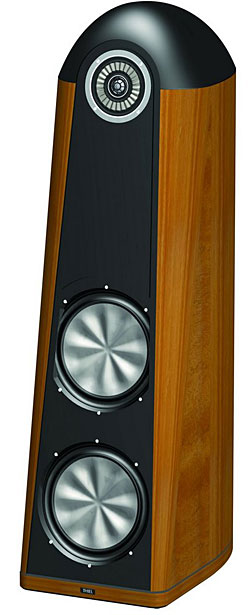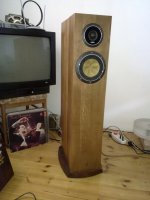Are there any metal cone drivers with a pressed pattern in them that would impart stiffness but allow for a lighter cone? It would be like putting creases in aluminum foil to make it stiffer. I imagine something like a spider web pattern or geometric shapes like a soccer (foot) ball. I remember tweeter compression drivers (JBL?) with hexagonal patterns stamped in them but nothing done in a larger scale. The creases could be very small to get a honeycomb effect or large to have a revelerator cut cone effect.
I remember, the Dalek looking thing. I was thinking more along the lines of something I could buy.Yes, thiel audio cs3.7
The Blade has a similar wavy midrange coaxial.
More than 20 years ago I had Fostex speakers with wavy diffusers, they were good speakers, frequency range 0-10000 Hz, sensitivity 90 dB, ceramic diffuser and covered with wool, corrugation of complex intelligent shape and double centering washer, huge magnet, slightly larger than the diffuser .
The HF tweeter is also Fostex. I placed them in an oak cabinet with an acoustic labyrinth design.
That was a long time ago.
By the way, I remember Loewe TV with a warm feeling; it was a good TV at that time😍.
The HF tweeter is also Fostex. I placed them in an oak cabinet with an acoustic labyrinth design.
That was a long time ago.
By the way, I remember Loewe TV with a warm feeling; it was a good TV at that time😍.
Attachments
All the SB aluminium (NAC) and ceramic (CAC) drivers have this pressed pattern, I think.SB65WBAC25-4 - five radial lines stamped into the cone
yes, it’s a good idea, no I don’t know why it’s not more common. Sure would help with making crossovers simpler
Technics used a honeycomb structure for their flat "honeycomb disk speakers":
https://www.preservationsound.com/wp-content/uploads/2013/09/Technics_SB-10_spkrs.pdf
By the way: A cone is geometrically very stiff by itself.
https://www.preservationsound.com/wp-content/uploads/2013/09/Technics_SB-10_spkrs.pdf
By the way: A cone is geometrically very stiff by itself.
Last edited:
So wavy ones are stamped ones.Actually I was thinking along the lines of the stamped SB65WBAC25 not the wavy bent diaphragms.
My idea was a stamped diaphragm that is stamped in a geometric or fractal pattern to reduce unwanted harmonics and strengthen the diaphragm.
The advantage of such diffusers is not only rigidity, which means maintaining their shape during operation, but also a real increase in the diffuser area.
Yes, but a cone still allows room for improvement. The "thicker" you make something, the more acoustically stiff it gets, generally, especially if you don't add any mass.Technics used a honeycomb structure for their flat "honeycomb disk speakers":
https://www.preservationsound.com/wp-content/uploads/2013/09/Technics_SB-10_spkrs.pdf
By the way: A cone is geometrically very stiff by itself.
I was thinking stamped, ka’chunk as opposed to pressed, tizzz-tink. 🤷 I guess there isn’t much of a distinction.So wavy ones are stamped ones.
The advantage of such diffusers is not only rigidity, which means maintaining their shape during operation, but also a real increase in the diffuser area.
My idea is to press the cone in a way that reduces unwanted harmonics, not unlike the painted dots idea.
The shape or stiffness of the cone will only slightly affect the harmonic distortion, if at all, as most of that comes from the motor. Unless you're talking about the amplification of harmonics due to cone resonance?
I think you're really talking about cone break-up resonances, rather than harmonic distortion?
Generally speaking, the SB NAC and CAC drivers have less in the way of pronounced break up peaks than most other hard cones. I guess that may be in part because of the pressed pattern.
Generally speaking, the SB NAC and CAC drivers have less in the way of pronounced break up peaks than most other hard cones. I guess that may be in part because of the pressed pattern.
Any cone will have phase problems because it is a cone. To be honest, I don’t understand what “pressing” can do in this sense. But “pressing” to make the cone flat is another matter😀.
That was one of the interesting points of the Thiel design. The midrange was pretty flat physically.
I never said anything about harmonic distortion, but, yes the idea is to reduce unwanted resonances, harmonic or non-harmonic, by using a stamped organic or random pattern.I think you're really talking about cone break-up resonances, rather than harmonic distortion?
Generally speaking, the SB NAC and CAC drivers have less in the way of pronounced break up peaks than most other hard cones. I guess that may be in part because of the pressed pattern.
OK, sorry. In post 13 you said this:
Look at the SB NAC and CAC ranges. I've suggested them three times now, so that's me done, over and out.
I'm not sure what you meant by unwanted harmonics, then, but I'm just trying to help.My idea is to press the cone in a way that reduces unwanted harmonics, not unlike the painted dots idea
Look at the SB NAC and CAC ranges. I've suggested them three times now, so that's me done, over and out.
Last edited:
- Home
- Loudspeakers
- Planars & Exotics
- Another ‘Are there any drivers like this’ question. Creased metal cones?

